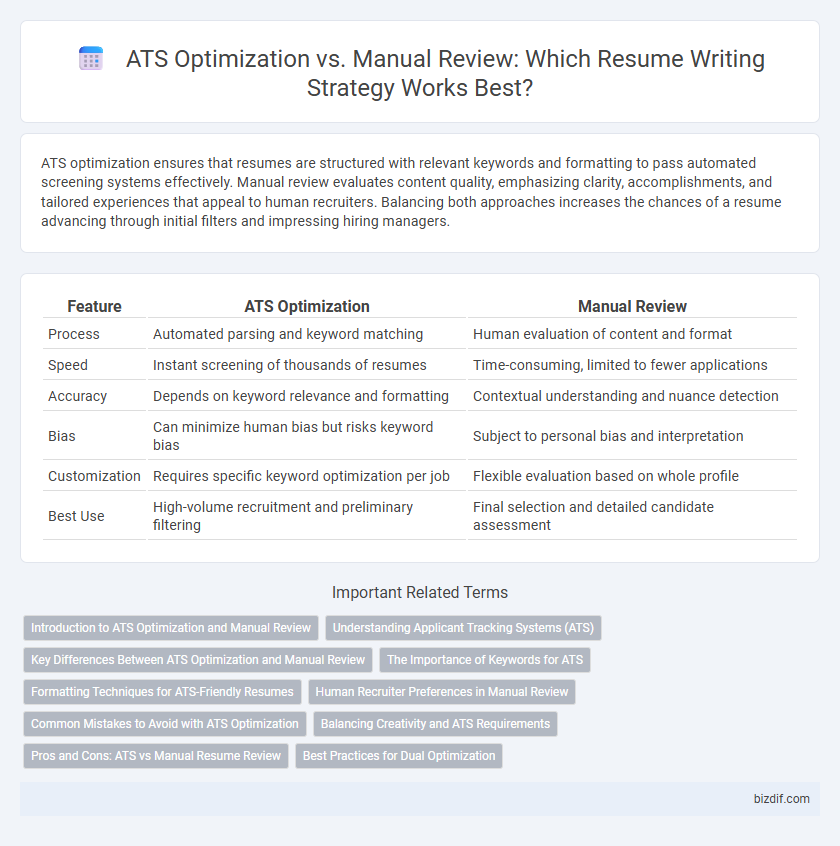ATS optimization ensures that resumes are structured with relevant keywords and formatting to pass automated screening systems effectively. Manual review evaluates content quality, emphasizing clarity, accomplishments, and tailored experiences that appeal to human recruiters. Balancing both approaches increases the chances of a resume advancing through initial filters and impressing hiring managers.
Table of Comparison
| Feature | ATS Optimization | Manual Review |
|---|---|---|
| Process | Automated parsing and keyword matching | Human evaluation of content and format |
| Speed | Instant screening of thousands of resumes | Time-consuming, limited to fewer applications |
| Accuracy | Depends on keyword relevance and formatting | Contextual understanding and nuance detection |
| Bias | Can minimize human bias but risks keyword bias | Subject to personal bias and interpretation |
| Customization | Requires specific keyword optimization per job | Flexible evaluation based on whole profile |
| Best Use | High-volume recruitment and preliminary filtering | Final selection and detailed candidate assessment |
Introduction to ATS Optimization and Manual Review
Applicant Tracking System (ATS) optimization involves tailoring resumes using specific keywords, formats, and structures to ensure seamless parsing by automated systems, increasing the chances of passing initial digital screenings. Manual review, on the other hand, requires crafting resumes that highlight clear, concise, and relevant information to capture the attention of human recruiters who assess experience, skills, and achievements personally. Understanding the balance between ATS optimization and manual review is crucial for maximizing resume effectiveness in both automated and human screening environments.
Understanding Applicant Tracking Systems (ATS)
Applicant Tracking Systems (ATS) scan resumes for specific keywords, formats, and data structures to efficiently rank candidates based on job relevance. Optimizing a resume for ATS involves incorporating industry-specific keywords, standard headings, and simple formatting to increase the likelihood of passing initial automated screenings. Manual review follows ATS filtration, where hiring managers assess resumes for qualifications and cultural fit beyond algorithmic evaluation.
Key Differences Between ATS Optimization and Manual Review
ATS optimization involves tailoring resumes with specific keywords, formatting, and structures to pass automated Applicant Tracking Systems, which scan for relevant skills and experience data points. Manual review focuses on human recruiters assessing overall content quality, clarity, and relevance, considering soft skills and contextual information beyond keyword matching. Understanding these key differences helps job seekers balance keyword density for ATS algorithms and compelling narratives for human readers.
The Importance of Keywords for ATS
Keywords play a crucial role in ATS optimization, as applicant tracking systems scan resumes for specific terms related to job descriptions. Strategic keyword placement increases the likelihood of a resume passing the initial automated screening and reaching a human reviewer. Including industry-specific jargon, relevant skills, and action verbs ensures alignment with both ATS algorithms and manual review criteria.
Formatting Techniques for ATS-Friendly Resumes
Effective ATS optimization requires clean, simple formatting that uses standard fonts, bullet points, and clear section headings to ensure keyword recognition. Avoiding tables, graphics, and complex layouts improves ATS readability, increasing the chances of passing initial automated screening. Manual review benefits from a polished, visually appealing format but should not compromise ATS compatibility for best results.
Human Recruiter Preferences in Manual Review
Human recruiters favor resumes that balance ATS optimization with clear, concise formatting and relevant keywords. Unlike ATS systems that scan for specific terms, recruiters prioritize readability, context, and evidence of skills, focusing on tailored achievements and personalized content. Emphasizing quantifiable results and coherent narratives enhances the resume's appeal during manual review.
Common Mistakes to Avoid with ATS Optimization
Common mistakes in ATS optimization include overloading resumes with keywords, which can appear unnatural and reduce readability during manual reviews. Using non-standard fonts, graphics, or complex formatting often causes parsing errors in ATS, leading to critical information being overlooked. Avoiding these errors ensures that resumes pass through ATS filters effectively while maintaining clarity for human recruiters.
Balancing Creativity and ATS Requirements
Balancing creativity with ATS optimization involves crafting resumes that incorporate relevant keywords and structured formatting to pass automated screenings while maintaining engaging and personalized content for human reviewers. Strategic use of industry-specific terms and clear section headers ensures compatibility with applicant tracking systems without sacrificing individuality. Effective resumes blend keyword optimization with concise, impactful language that highlights unique skills and experiences to appeal to both algorithms and hiring managers.
Pros and Cons: ATS vs Manual Resume Review
ATS optimization efficiently scans resumes for keyword relevance, increasing the chances of passing initial screening but may overlook nuanced qualifications and context. Manual review provides a comprehensive evaluation of a candidate's skills and experiences, capturing subtle strengths and cultural fit, yet it is time-consuming and subject to human bias. Balancing ATS-friendly formatting with content appealing to human reviewers enhances overall resume effectiveness in job applications.
Best Practices for Dual Optimization
Employ keyword-rich phrases aligned with the job description to enhance ATS optimization while maintaining natural, clear language for manual review. Use standard section headings and simple formatting to ensure ATS compatibility without sacrificing readability for recruiters. Customize resumes for each application by integrating relevant skills and achievements, balancing machine parsing requirements with human engagement.
ATS Optimization vs Manual Review Infographic

 bizdif.com
bizdif.com